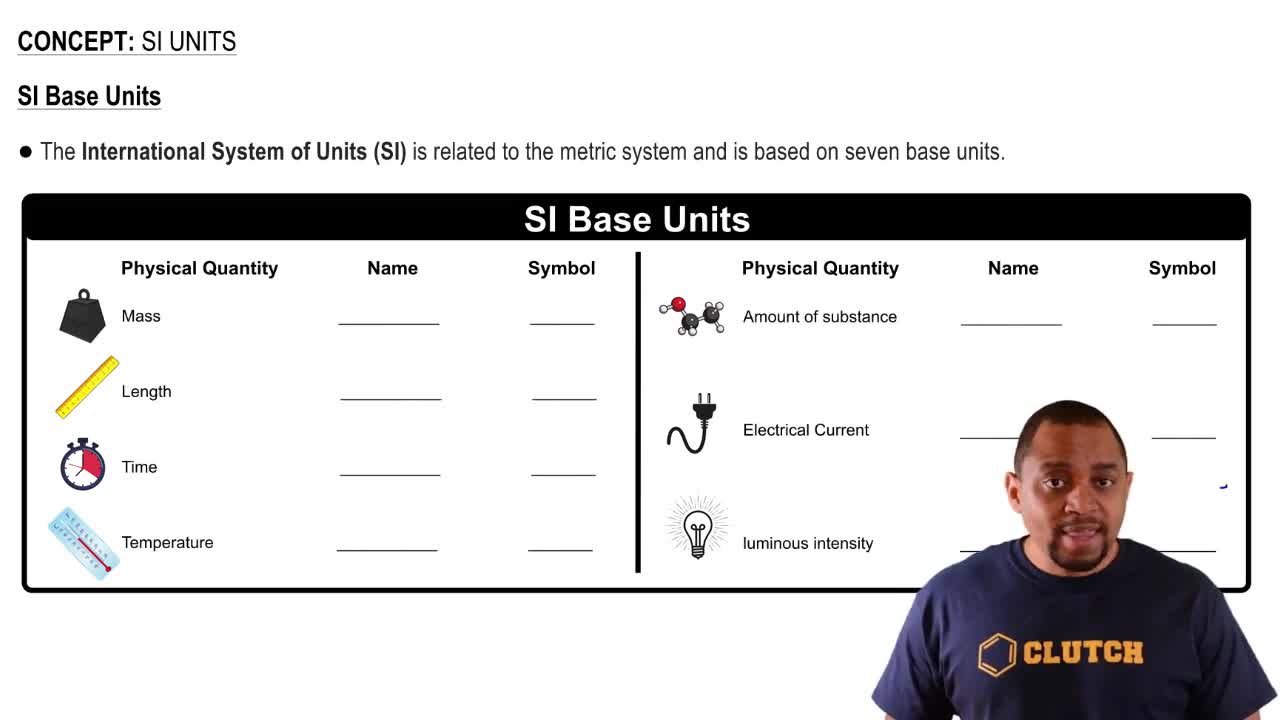What SI units are used for measuring the following quanti-ties? For derived units, express your answers in terms of the six fundamental units. (b) Length
Ch.1 - Chemical Tools: Experimentation & Measurement
Chapter 1, Problem 38e
What SI units are used for measuring the following quanti-ties? For derived units, express your answers in terms of the six fundamental units. (e) Energy
 Verified step by step guidance
Verified step by step guidance1
Identify the SI unit for energy, which is the joule (J).
Recall that energy is a derived unit in the SI system.
Express the joule in terms of the fundamental SI units: 1 joule is equivalent to 1 newton meter (N·m).
Break down the newton (N) into fundamental units: 1 newton is equal to 1 kilogram meter per second squared (kg·m/s²).
Combine these to express the joule in terms of fundamental units: 1 J = 1 kg·m²/s².

Verified video answer for a similar problem:
This video solution was recommended by our tutors as helpful for the problem above.
Video duration:
1mWas this helpful?
Key Concepts
Here are the essential concepts you must grasp in order to answer the question correctly.
SI Units
The International System of Units (SI) is a standardized system of measurement used globally in science and engineering. It consists of seven base units, including the meter (length), kilogram (mass), second (time), ampere (electric current), kelvin (temperature), mole (amount of substance), and candela (luminous intensity). Derived units are formed from these base units to measure other quantities, such as energy.
Recommended video:
Guided course

SI Units
Energy and Its Units
Energy is the capacity to do work or produce heat and is measured in joules (J) in the SI system. One joule is defined as the energy transferred when a force of one newton is applied over a distance of one meter. Understanding energy's relationship with other physical quantities, such as mass and velocity, is essential for converting between different units of energy.
Recommended video:
Guided course

SI Units
Derived Units
Derived units are combinations of the seven base SI units used to express physical quantities. For example, energy (joules) can be expressed in terms of base units as kg·m²/s², where kg is kilograms, m is meters, and s is seconds. Recognizing how to derive these units from fundamental quantities is crucial for accurately measuring and converting various physical properties.
Recommended video:
Guided course

Ideal Gas Law Derivations
Related Practice
Textbook Question
5
views
Textbook Question
What SI units are used for measuring the following quanti-ties? For derived units, express your answers in terms of the six fundamental units. (c) Temperature
9
views
Textbook Question
What SI units are used for measuring the following quanti-ties? For derived units, express your answers in terms of the six fundamental units. (d) Volume
9
views
Textbook Question
What SI units are used for measuring the following quanti-ties? For derived units, express your answers in terms of the six fundamental units. (e) Energy
1
views
Textbook Question
What SI units are used for measuring the following quanti-ties? For derived units, express your answers in terms of the six fundamental units. (f) Density
24
views
Textbook Question
Complete the following equivalent expressions by filling in the blanks.(a) 1 km = ____ m(b) 1m = _____ km(c) 1 mmol = _____ mol(d) 1 mol = _____ mmol
3
views
